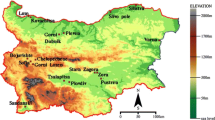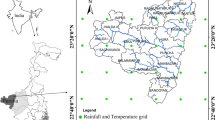Abstract
In this study, rainfed wheat and barley yields response to severity and persistence of cold temperature extremes in the January-February-March (JFM) and high temperature, low rainfall, and soil water shortage extremes in the October-November-December (OND) and March-April-May (MAM) was evaluated. For this purpose, the associations between the yields and the extreme indices were tested using Pearson’s correlation coefficient for 10 sites located in the western Iran over 1982–2013. The FAO-56 soil water balance model was employed to develop the soil water deficit extreme indices. The impacts of extremes on the yields were also investigated under El Niño–Southern Oscillation (ENSO) phases. The yields were anti-correlated significantly (p < 0.05) with the soil water shortage and rainfall deficit extreme indices, but not with the temperature-related extreme indices, for the majority of sites. On average, a more negative association also existed between the yields and the soil moisture-related indices relative to the rainfall and temperature extreme indices. The yields seem, therefore, to be more adversely impacted by agricultural droughts. Compared with the OND extremes, the high temperature, precipitation shortage, and soil water deficit extremes in MAM had more negative effects on the yields. This can be attributable to strong sensitivity of reproductive processes commonly occurring during MAM to such stresses. In most cases, the yields were more adversely influenced by the short-term extremes. The results also revealed that more frequent occurrence of high temperature and drought-related extremes during La Niña can well explain the substantial yield loss in cold ENSO years.






Similar content being viewed by others
References
Alizadeh-Choobari O, Najafi MS (2017) Extreme weather events in Iran under a changing climate. Clim Dyn 50:249–260. https://doi.org/10.1007/s00382-017-3602-4
Allen RG, Pereira LS, Raes D, Smith M (1998) Crop evapotranspiration—guidelines for computing crop water requirements—FAO Irrigation and drainage paper 56. Food and Agriculture Organization of the United Nations, Rome
Bannayan M, Lakzian A, Gorbanzadeh N, Roshani A (2011a) Variability of growing season indices in northeast of Iran. Theor Appl Climatol 105:485–494. https://doi.org/10.1007/s00704-011-0404-1
Bannayan M, Sadeghi Lotfabadi S, Sanjani S, Mohamadian A, Aghaalikhani M (2011b) Effects of precipitation and temperature on crop production variability in northeast Iran. Int J Biometeorol 55:387–401. https://doi.org/10.1007/s00484-010-0348-7
Bannayan M, Sanjani S, Alizadeh A, Lotfabadi SS, Mohamadian A (2010) Association between climate indices, aridity index, and rainfed crop yield in northeast of Iran. Field Crop Res 118:105–114. https://doi.org/10.1016/j.fcr.2010.04.011
Beyazgül M, Kayam Y, Engelsman F (2000) Estimation methods for crop water requirements in the Gediz Basin of western Turkey. J Hydrol 229:19–26. https://doi.org/10.1016/S0022-1694(99)00196-1
Cai W, Borlace S, Lengaigne M, van Rensch P, Collins M, Vecchi G, Timmermann A, Santoso A, McPhaden MJ, Wu L, England MH, Wang G, Guilyardi E, Jin FF (2014) Increasing frequency of extreme El Niño events due to greenhouse warming. Nat Clim Chang 4:111–116. https://doi.org/10.1038/nclimate2100
Dai A (2011) Drought under global warming: a review. Wiley Interdiscip Rev Clim Chang 2:45–65. https://doi.org/10.1002/wcc.81
Dastane N (1974) Effective rainfall in irrigated agriculture—FAO Irrigation and drainage paper 25. Food and Agriculture Organization of the United Nations, Rome
Deryng D, Conway D, Ramankutty N, Price J, Warren R (2014) Global crop yield response to extreme heat stress under multiple climate change futures. Environ Res Lett 9:034011. https://doi.org/10.1088/1748-9326/9/3/034011
Dorigo WA, Wagner W, Hohensinn R, Hahn S, Paulik C, Xaver A, Gruber A, Drusch M, Mecklenburg S, van Oevelen P, Robock A, Jackson T (2011) The International Soil Moisture Network: a data hosting facility for global in situ soil moisture measurements. Hydrol Earth Syst Sci 15:1675–1698. https://doi.org/10.5194/hess-15-1675-2011
Er-Raki S, Chehbouni A, Guemouria N, Duchemin B, Ezzahar J, Hadria R (2007) Combining FAO-56 model and ground-based remote sensing to estimate water consumptions of wheat crops in a semi-arid region. Agric Water Manag 87:41–54. https://doi.org/10.1016/j.agwat.2006.02.004
Fontana G, Toreti A, Ceglar A, De Sanctis G (2015) Early heat waves over Italy and their impacts on durum wheat yields. Nat Hazards Earth Syst Sci 15:1631–1637. https://doi.org/10.5194/nhess-15-1631-2015
Ford TW, Quiring SM, Frauenfeld OW (2017) Multi-decadal variability of soil moisture-temperature coupling over the contiguous United States modulated by Pacific and Atlantic Sea surface temperatures. Int J Climatol 37:1400–1415. https://doi.org/10.1002/joc.4785
Ghasemi AR, Khalili D (2006) The influence of the Arctic Oscillation on winter temperatures in Iran. Theor Appl Climatol 85:149–164. https://doi.org/10.1007/s00704-005-0186-4
Hirschi M, Seneviratne SI, Alexandrov V, Boberg F, Boroneant C, Christensen OB, Formayer H, Orlowsky B, Stepanek P (2010) Observational evidence for soil-moisture impact on hot extremes in southeastern Europe. Nat Geosci 4:17–21. https://doi.org/10.1038/ngeo1032
Holmes A, Rüdiger C, Mueller B, Hirschi M, Tapper N (2017) Variability of soil moisture proxies and hot days across the climate regimes of Australia. Geophys Res Lett 44:7265–7275. https://doi.org/10.1002/2017gl073793
Iizumi T, Luo JJ, Challinor AJ, Sakurai G, Yokozawa M, Sakuma H, Brown ME, Yamagata T (2014) Impacts of El Nino Southern Oscillation on the global yields of major crops. Nat Commun 5:3712. https://doi.org/10.1038/ncomms4712
Kim T-W, Valdés JB, Nijssen B, Roncayolo D (2006) Quantification of linkages between large-scale climatic patterns and precipitation in the Colorado River Basin. J Hydrol 321:173–186. https://doi.org/10.1016/j.jhydrol.2005.07.043
Kolář P, Trnka M, Brázdil R, Hlavinka P (2013) Influence of climatic factors on the low yields of spring barley and winter wheat in Southern Moravia (Czech Republic) during the 1961–2007 period. Theor Appl Climatol 117:707–721. https://doi.org/10.1007/s00704-013-1037-3
Lalic B, Eitzinger J, Mihailovic DT, Thaler S, Jancic M (2012) Climate change impacts on winter wheat yield change—which climatic parameters are crucial in Pannonian lowland? J Agric Sci 151:757–774. https://doi.org/10.1017/s0021859612000640
Liu D, Wang G, Mei R, Yu Z, Yu M (2014) Impact of initial soil moisture anomalies on climate mean and extremes over Asia. J Geophys Res Atmos 119:529–545. https://doi.org/10.1002/2013JD020890
Lobell D (2010) Crop responses to climate: time-series models. In: Lobell D, Burke M (eds) Climate change and food security: adapting agriculture to a warmer world. Springer Netherlands, Dordrecht, pp 85–98. https://doi.org/10.1007/978-90-481-2953-9_5
Lobell DB (2007) Changes in diurnal temperature range and national cereal yields. Agric For Meteorol 145:229–238. https://doi.org/10.1016/j.agrformet.2007.05.002
Lüttger AB, Feike T (2017) Development of heat and drought related extreme weather events and their effect on winter wheat yields in Germany. Theor Appl Climatol 132:15–29. https://doi.org/10.1007/s00704-017-2076-y
Madani K (2014) Water management in Iran: what is causing the looming crisis? J Environ Stud Sci 4:315–328. https://doi.org/10.1007/s13412-014-0182-z
Mathias H, René O, Sonia IS (2016) Role of soil moisture versus recent climate change for the 2010 heat wave in western Russia. Geophys Res Lett 43:2819–2826. https://doi.org/10.1002/2016GL068036
Mavromatis T (2014) Crop–climate relationships of cereals in Greece and the impacts of recent climate trends. Theor Appl Climatol 120:417–432. https://doi.org/10.1007/s00704-014-1179-y
McPhaden MJ, Zebiak SE, Glantz MH (2006) ENSO as an integrating concept in earth science. Science 314:1740–1745. https://doi.org/10.1126/science.1132588
Mueller B, Seneviratne SI (2012) Hot days induced by precipitation deficits at the global scale. PNAS 109:12398–12403. https://doi.org/10.1073/pnas.1204330109
Nazemosadat MJ, Cordery I (2000) On the relationships between ENSO and autumn rainfall in Iran. Int J Climatol 20:47–61. https://doi.org/10.1002/(SICI)1097-0088(200001)20:1<47::AID-JOC461>3.0.CO;2-P
Nazemosadat MJ, Ghasemi AR (2004) Quantifying the ENSO-related shifts in the intensity and probability of drought and wet periods in Iran. J Clim 17:4005–4018. https://doi.org/10.1175/1520-0442(2004)017<4005:qtesit>2.0.co;2
Nicolas ME, Gleadow RM, Dalling MJ (1984) Effects of drought and high temperature on grain growth in wheat. Aust J Plant Physiol 11:553. https://doi.org/10.1071/pp9840553
Nouri M, Homaee M (2018) On modeling reference crop evapotranspiration under lack of reliable data over Iran. J Hydrol 566:705–718. https://doi.org/10.1016/j.jhydrol.2018.09.037
Nouri M, Homaee M, Bannayan M (2017a) Climate variability impacts on rainfed cereal yields in west and Northwest Iran. Int J Biometeorol 61:1571–1583. https://doi.org/10.1007/s00484-017-1336-y
Nouri M, Homaee M, Bannayan M (2018) Spatiotemporal reference evapotranspiration changes in humid and semi-arid regions of Iran: past trends and future projections. Theor Appl Climatol 133:361–375. https://doi.org/10.1007/s00704-017-2176-8
Nouri M, Homaee M, Bannayan M, Hoogenboom G (2016) Towards modeling soil texture-specific sensitivity of wheat yield and water balance to climatic changes. Agric Water Manag 177:248–263. https://doi.org/10.1016/j.agwat.2016.07.025
Nouri M, Homaee M, Bannayan M, Hoogenboom G (2017b) Towards shifting planting date as an adaptation practice for rainfed wheat response to climate change. Agric Water Manag 186:108–119. https://doi.org/10.1016/j.agwat.2017.03.004
OCHA (2000) United Nations technical mission on the drought situation in the Islamic republic of Iran. UN Mission Report. Office for the Coordination of Humanitarian Affairs, Tehran
Pingali PL (2012) Green revolution: impacts, limits, and the path ahead. PNAS 109:12302–12308. https://doi.org/10.1073/pnas.0912953109
Podestá G, Letson D, Messina C, Royce F, Ferreyra RA, Jones J, Hansen J, Llovet I, Grondona Ḿ, O'Brien JJ (2002) Use of ENSO-related climate information in agricultural decision making in Argentina: a pilot experience. Agric Syst 74:371–392. https://doi.org/10.1016/S0308-521X(02)00046-X
Prasad PVV, Pisipati SR, Momčilović I, Ristic Z (2011) Independent and combined effects of high temperature and drought stress during grain filling on plant yield and chloroplast EF-Tu expression in spring wheat. J Agron Crop Sci 197:430–441. https://doi.org/10.1111/j.1439-037X.2011.00477.x
Raes D, Steduto P, Hsiao TC, Fereres E (2009) AquaCrop—the FAO crop model to simulate yield response to water: II. Main algorithms and software description. Agron J 101:438. https://doi.org/10.2134/agronj2008.0140s
Rahimi M, Hejabi S (2018) Spatial and temporal analysis of trends in extreme temperature indices in Iran over the period 1960-2014. Int J Climatol 38:272–282. https://doi.org/10.1002/joc.5175
Rawls WJ, Brakensiek DL, Saxtonn KE (1982) Estimation of soil water properties. Trans ASAE 25:1316–1320. https://doi.org/10.13031/2013.33720
Ray DK, Gerber JS, MacDonald GK, West PC (2015) Climate variation explains a third of global crop yield variability. Nat Commun 6:5989. https://doi.org/10.1038/ncomms6989
Robinson DA, Campbell CS, Hopmans JW, Hornbuckle BK, Jones SB, Knight R, Ogden F, Selker J, Wendroth O (2008) Soil moisture measurement for ecological and hydrological watershed-scale observatories: a review. Vadose Zone J 7:358–389. https://doi.org/10.2136/vzj2007.0143
Rockström J et al (2007) Managing water in rainfed agriculture. In: Molden DE (ed) water for food water for life: a comprehensive assessment of water Management in Agriculture. Earthscan, London, and international water management institute, Colombo, pp 311–352
Rodwll RJ (2003) On the predictability of North Atlantic climate. In: Kushnir Y, Ottersen G, Visbeck M (eds) The North Atlantic Oscillation, climatic significance and environmental impact, vol 134. AGU Geophys Monogr 134:173–192. https://doi.org/10.1029/134GM08
Sadeghi AR, Kamgar-Haghighi AA, Sepaskhah AR, Khalili D, Zand-Parsa S (2002) Regional classification for dryland agriculture in southern Iran. J Arid Environ 50:333–341. https://doi.org/10.1006/jare.2001.0822
Saxton KE, Rawls WJ, Romberger JS, Papendick RI (1986) Estimating generalized soil-water characteristics from texture1. Soil Sci Soc Am J 50:1031–1036. https://doi.org/10.2136/sssaj1986.03615995005000040039x
Seneviratne SI, Corti T, Davin EL, Hirschi M, Jaeger EB, Lehner I, Orlowsky B, Teuling AJ (2010) Investigating soil moisture–climate interactions in a changing climate: a review. Earth Sci Rev 99:125–161. https://doi.org/10.1016/j.earscirev.2010.02.004
Shah NH, Paulsen GM (2003) Interaction of drought and high temperature on photosynthesis and grain-filling of wheat. Plant Soil 257:219–226. https://doi.org/10.1023/a:1026237816578
Sims AP, Niyogie DS, Raman S (2002) Adopting drought indices for estimating soil moisture: A North Carolina case study. Geophys Res Lett 29:24–21–24-24. https://doi.org/10.1029/2001gl013343
Sinclair TR, Muchow RC (2001) System analysis of plant traits to increase grain yield on limited water supplies. Agron J 93:263–270. https://doi.org/10.2134/agronj2001.932263x
Tangang FT, Tang B, Monahan AH, Hsieh WW (1998) Forecasting ENSO events: a neural network–extended EOF approach. J Clim 11:29–41. https://doi.org/10.1175/1520-0442(1998)011<0029:feeann>2.0.co;2
Trigo RM, Gouveia CM, Barriopedro D (2010) The intense 2007–2009 drought in the Fertile Crescent: impacts and associated atmospheric circulation. Agric For Meteorol 150:1245–1257. https://doi.org/10.1016/j.agrformet.2010.05.006
UNEP (1997) World atlas of desertification. Arnold, Hodder Headline, PLC, London
Williams JR, Jones CA, Dyke PT (1984) A modeling approach to determining the relationship between Erosion and soil productivity. Trans ASAE 27:129. https://doi.org/10.13031/2013.32748
Author information
Authors and Affiliations
Corresponding author
Additional information
Publisher’s note
Springer Nature remains neutral with regard to jurisdictional claims in published maps and institutional affiliations.
Rights and permissions
About this article
Cite this article
Nouri, M., Bannayan, M. On soil moisture deficit, low precipitation, and temperature extremes impacts on rainfed cereal productions in Iran. Theor Appl Climatol 137, 2771–2783 (2019). https://doi.org/10.1007/s00704-019-02766-3
Received:
Accepted:
Published:
Issue Date:
DOI: https://doi.org/10.1007/s00704-019-02766-3




